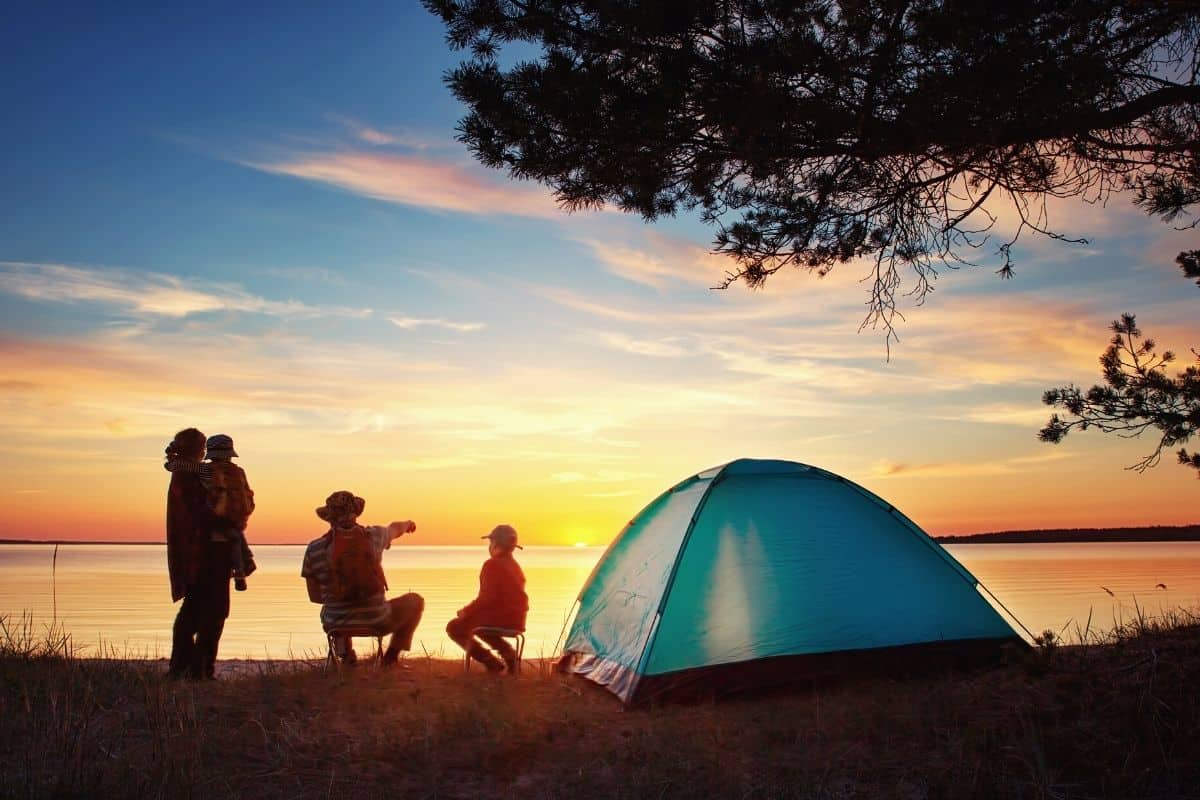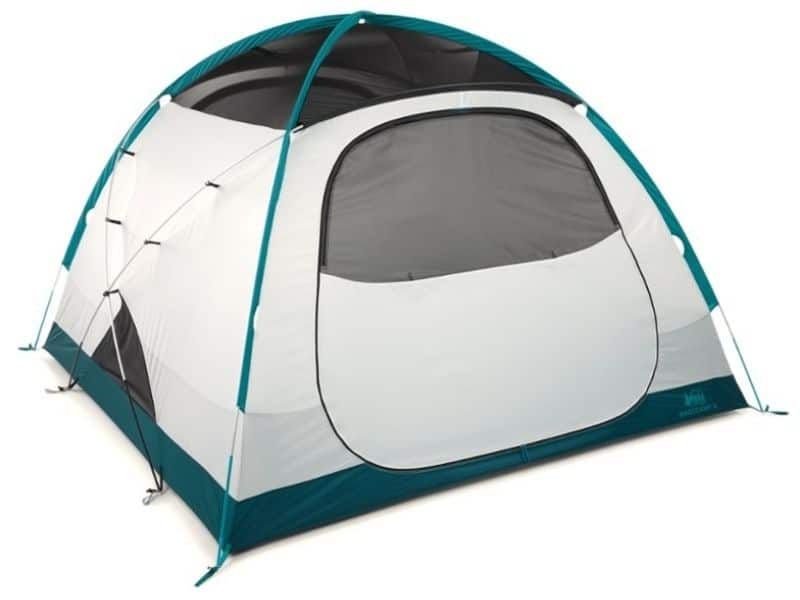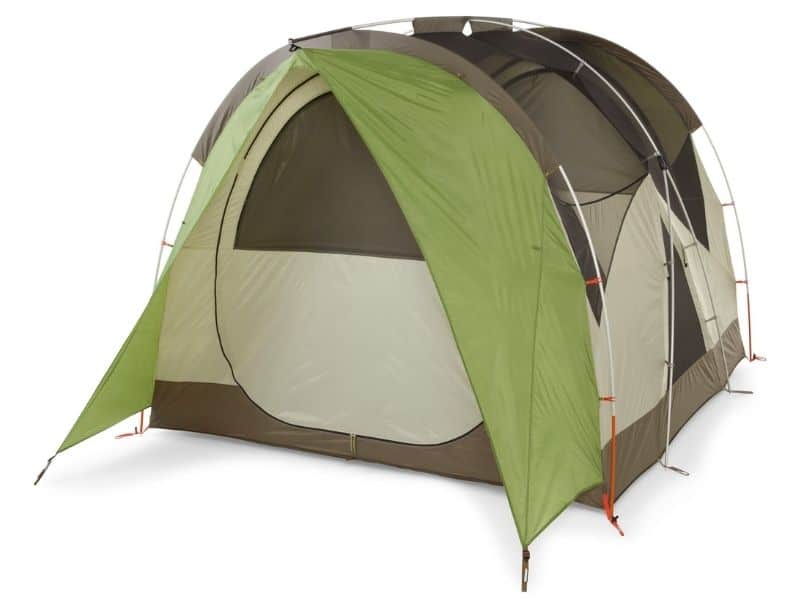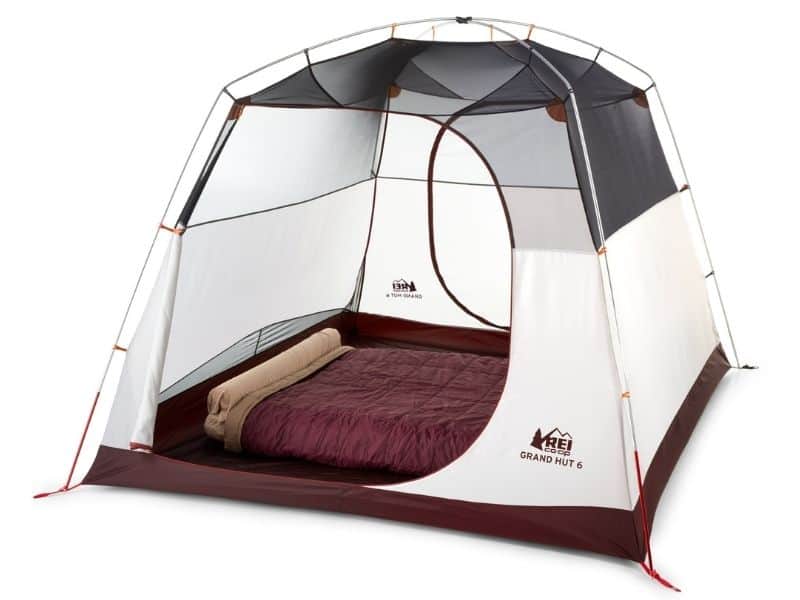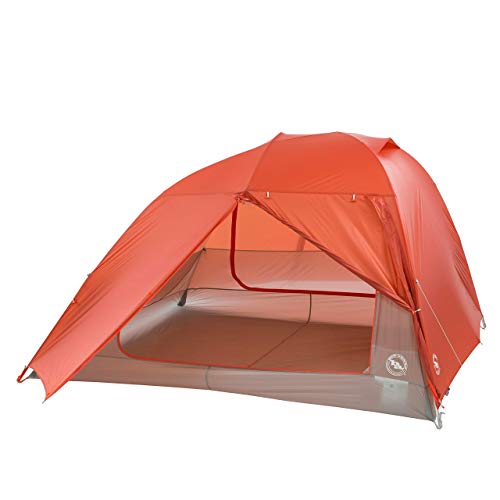Our extensive testing resulted in the REI Co-op Basecamp topping our list as the best family tent for the second year in a row.
However, with reviews of the REI Co-Op Base Camp 6, the North Face Wawona 6, REI Wonderland 4, REI Co-Op Grand Hut 6, Big Agnes Big House 6, Coleman Instant Cabin, Eureka Copper Canyon LX 8, Big Agnes Copper Spur HV UL and Coleman Skydome 6 you’re sure to find a superb tent to meet your needs.
If you’re a novice camper or need some help deciding which tent will work best for your family, scroll down – below our list of tents you’ll find expert advice on all the things you need to consider before buying.
Table of Contents
At a Glance: Quick Recommendations
-
Editor’s Choice:
REI Co-Op Base Camp 6
“Roomy, waterproof, feature-rich, and the best family car-camping tent out there by a large margin.” -
Best for Livability:
The North Face Wawona 6
“The Wawona has a roomy interior and a spacious vestibule big enough to park your car in.” -
Best 4-Person Tent:
REI Co-op Wonderland 4
“This new kid on the block is sure to become a best-seller.” -
Best Value:
REI Co-op Grand Hut 6
“An affordable tent for car-camping that offers oodles of space and all the dialed-in features we’ve come to expect of REI family tents.” -
Best Cabin Tent:
Big Agnes Big House 6
“Steep walls and on-the-nail features make this one of the most livable family tents out there.” -
Best Instant Tent:
Coleman Cabin Tent (Instant)
“The ideal choice for anyone keen to take the stress and strain out of their family camping trip (at least, that is, the stress and strain experienced during setup!).” -
Best 8-Person Tent:
Eureka Copper Canyon 8
“An extra-roomy family tent that comes into its own in warm weather.” -
Best for Backpacking:
Big Agnes Copper Spur HV UL
“Short on space, but light enough for multi-day family trips in the backcountry.” -
Best Budget:
Coleman Skydome 6
“The best tent out there for families looking to maximize bang for their buck.”
Which is the Best Family tent?
Before settling on the REI Base Camp as our favorite family tent, we tested family camping tents from many brands and shortlisted the following large family tents.
- REI Co-Op Base Camp 6 Tent
- The North Face Wawona 6
- REI Wonderland 4
- REI Grand Hut 6
- Big Agnes Big House 6
- Coleman Instant Cabin Tent
- Eureka Copper Canyon LX 8
- Big Agnes Copper Spur HV UL
- Coleman Skydome 6
REI Co-Op Base Camp 6 Tent
Editor’s ChoiceType: Dome ⸱ Interior Space: 84 sq. ft. ⸱ Peak Height: 74” ⸱ Weight: 20 lbs. 10 oz.
The REI Co-Op Base Camp 6 scoops our best family tent award because it does everything camping families need a tent to do – and at a reasonable price. It’s spacious, easy to pitch, performs well in hot and wet weather, and has plenty of storage options to optimize livability.
While the Base Camp’s geodesic, dome-style design means it has slightly less headroom than tunnel or cabin tents, it makes it more stable in windy conditions. Its peak height of 74 inches is also impressive for a dome-style tent – just bear in mind that this will decrease the further you get from the tent’s center.
The Base Camp is made with among the burliest materials on our list. That includes a 75D rainfly and body fabric, and 150D floor, all of which are waterproof enough for 3- or even 4-season use.
The Base Camp is also full of value-adding features that our testers loved. It has two large air vents in the roof to boost airflow, 14 pockets for gear storage, hang loops, two large vestibules, and two huge doors.
While not as roomy as the TNF Wawona, its superior weather protection and bountiful features will make the Base Camp a better tent for some.
If the 6-person version of this tent is overkill for your needs, be sure to check out the Base Camp 4.
PROs
- Spacious interior
- Excellent weather resistance
- Good peak height
- 2 roof vents and 1 wall vent
- 2 large vestibules
- Plenty of pockets
CONs
- Quite pricey
Bottom-Line: A spacious 6-person tent that outperforms all others on our list in wet weather and boasts a shedload of practicality- and convenience-enhancing features.
The North Face Wawona 6
Best for LivabilityType: Extended dome ⸱ Interior Space: 86 sq. ft. ⸱ Peak Height: 80 inches ⸱ Weight: 20 lbs. 15 oz.
The NF Wawona 6 is among the most livable family tents out there and the perfect tent for families who require a little extra space for gear or R&R.
The Wawona has a whopping 86 sq. ft. of interior space, 44.7 sq. ft. of vestibule space, a peak height of 80”, and a ton of storage pockets to help you keep your gear organized and the tent floor free of clutter.
In testing, we loved the Wawona’s steep walls. This means that it boasts the structural solidity of dome tents but maximizes headroom by reducing the degree of curvature either side of center. This allows you to move around inside without having to hunch, which is a huge boon for livability.
The Wawona sleeps 6, but its huge front vestibule could easily accommodate another 2 or 3 sleepers, or serve as an oversize gear garage or hangout space for evening games and dining.
The previous version of the Wawona’s main shortcoming was its a partial-coverage rainfly. While the fly in the new version doesn’t cover the whole tent, it covers enough to ensure you’ll stay dry even in heavy downpours. The only other potential downside is that it has only one door (one, however, that’s big enough to drive a small vehicle through).
While a solid performer in wet weather, the Wawona comes into its own in hot weather. That huge vestibule means you can leave the door open to boost airflow without letting in bugs, while the large ceiling vents and mesh canopy keep stuffiness and condensation at bay when temps and humidity are high.
PROs
- Huge vestibule
- Huge door
- Storage pockets galore
- 80” peak height
- Great ventilation
CONs
- Partial-coverage rain fly
- Only 1 door
Bottom-Line: The ideal pick for families who camp with a lot of gear or simply prefer plenty of extra space.
REI Wonderland 4
Best 4-Person Family TentType: Tunnel ⸱ Interior Space: 69.4 square feet ⸱ Peak Height: 75” ⸱ Weight: 21 lbs. 11 oz.
The REI Wonderland 4 is the perfect family tent for smaller families – it’s roomy, rich in features, breezy to pitch, and great in both warm and wet weather.
Our testers were keen to try this new, updated, and improved version of REI’s hugely popular Kingdom tent, and it didn’t disappoint.
Like its predecessor, the Wonderland uses a tunnel-style design with near-vertical walls that maximize headroom. It also has strategic color-coding on the fly, poles, and footprint to make setup a cinch. We love the “scalloped” fly, which has extensive mesh panels and windows to provide 360° views, even with the fly on.
The Wonderland’s 69.4 square feet of floor space make it a roomy 4-person tent. However, unlike every other family tent on our list barring the Big Agnes Big House, it has no vestibule area, only a duo of small awnings that provide a sliver of cover over the doorways.
Like most REI shelters, this tent features are on the nail. You get a ton of interior pockets for gear storage, vents at top and bottom to stave off stuffiness and condensation, hanging hooks for a lantern or headlamp, and two extra-large doors that extend from top to bottom and wall to wall.
PROs
- Roomy interior
- Stable in strong winds
- Plenty of pockets
- Durable materials (75D fly, 150D floor)
CONs
- Only available to REI members
- Heavy
- No vestibule
Bottom-Line: A well-made three-season tent that’s ideal for smaller families – as long as you don’t need too much storage space.
REI Co-Op Grand Hut 6
Best ValueType: Cabin ⸱ Interior Space: 97.3 sq. ft. ⸱ Peak Height: 80” ⸱ Weight: 27 lbs.
The Grand Hut is the perfect choice of camping tent for families who want a high-performing, high-quality tent for six people without paying through the nose for it.
As with all things REI, this family tent is impressively well-made. It uses 75D fabric in the rainfly and body, and 150D fabric in the flooring, which makes it one of the toughest on our list. The rainfly’s 1,500mm hydrostatic head rating, along with the body’s mesh panels and the double-doored design, moreover, make it a solid performer in both wet and warm conditions.
In terms of livability, this tent is a winner. It has plenty of interior storage options, steep walls to maximize headroom, a 78” peak height, 83.3 sq. ft. of interior space, and a 36 sq. ft. vestibule. This means there’s not only plenty of room for 6 sleepers but also ample space for all of your gear.
In wild weather, this tent is a little less reliable than its close cousin, the REI Co-Op Base Camp, mainly because its vertical walls and 4-pole design make it more susceptible to billowing and/or buckling in strong winds. It also boasts fewer storage options than the Base Camp and a little less vestibule room, but has a lot more headroom and retails at a much friendlier price.
PROs
- Great peak height
- Relatively lightweight
- Good ventilation
- Very easy to set up
- Waterproof
CONs
- A poorer performer than the REI Co-Op Base Camp in inclement weather
Bottom-Line: An affordable, well-made, and spacious six-person tent that ticks every important box.
Big Agnes Big House 6
Best Cabin TentType: Cabin ⸱ Interior Space: 83 sq. ft. ⸱ Peak Height: 81” ⸱ Weight: 16 lbs. 7 oz.
The Big Agnes Big House is a great 6-person tent if you’re looking for a family-friendly tent that combines reliability with a wealth of fancy features.
This cabin-style tent boasts 83 square feet of floor space and a peak height of 81 inches. Despite the generosity of these dimensions, it weighs just 16 lbs. 7 oz., so could feasibly be used as a backpacking tent if the components were split between two or three carriers.
The Big House is a standout in two metrics: weather protection and livability. Its 1,500 mm rain fly and flooring ensures robust protection in all 3-season conditions. And although it lacks a vestibule, its steep walls and “high-volume architecture” make it feel extra-spacious inside. Four large wall pockets and corner bin pockets also partially make up for the lack of external storage.
What about those fancy features? Well, we’re not often the types to be swayed by non-essential bells and whistles, but there’s no denying that the extra-large welcome mat, a duo of huge doors, backpack-style carry bag, huge gear loft (sold separately), and unique “shelter mode” (lets you pitch the fly without the tent body on balmy, bug-free nights) are well worth having.
PROs
- Plenty of headroom
- Easy setup
- Relatively lightweight
- Roomy interior
- Fly converts into a freestanding portico
CONs
- No vestibule
- Pricey
Bottom-Line: Has a few shortcomings, but is nevertheless the best family tent out there for fans of a cabin-style design and extra headroom.
Coleman Instant Cabin Tent
Best Instant TentType: Instant Cabin ⸱ Interior Space: 90 sq. ft. ⸱ Peak Height: 72” ⸱ Weight: 24.9 lbs.
The Coleman Instant Cabin is the perfect tent for camping families who want to keep fuss to a minimum. Unlike the other tents we tested, this family pop-up tent can be pitched in next to no time and performs well in most other metrics to boot.
The pole structure of the Coleman Instant Cabin is a touch unique – instead of supporting the rainfly from the inside, it suspends the tent fabric from above. And therein lies the Instant Cabin’s genius. Not only do the poles have a telescoping design and pop into place around a central pole hub lickety-split, its integrated rainfly means that the whole pitching process takes around one minute.
The only grumble we have with this deisgn is that the integrated fly isn’t removable, meaning there’s no option to ditch it on hot and humid nights. This shortcoming is partially compensated for by the large vents/windows in the fly, but we’re always fans of having the option to shed weight and optimize airflow by leaving the fly at home when the forecast calls for clear skies.
PROs
- Roomy – fits 2 queen-size air beds
- 1-minute setup
- Integrated vented rainfly
- Solid weather protection
- 1-year warranty
CONs
- Relatively low peak height
- Lacks versatility
- Short on interior pockets
Bottom-Line: Ideal for car campers looking to minimize hassle when setting up and packing away.
Eureka Copper Canyon LX 8
Best 8-Person Family TentType: Cabin ⸱ Interior Space: 130 sq. ft. ⸱ Peak Height: 84” ⸱ Weight: 33 lbs. 8 oz.
The Eureka Copper Canyon XL won our testers’ vote as the best car-camping tent for large families owing to its abundant floor space and lofty peak height.
This 8-person tent is all about livability. While there’s no vestibule, it has 130 square feet of floor space, an 84-inch peak height, and steep walls that maximize headroom throughout the tent. This means it can comfortably accommodate a family of eight and is tall enough to let everyone walk around inside without having to hunch.
The Copper Canyon isn’t a standout in rainy weather due to its use of a partial-coverage rain fly. On the plus side, the minimalist fly means there’s plenty of airflow when camping in warm weather.
We were also impressed by the Copper Canyon’s feature set given its (relatively) low cost. It has a large extended awning for drying clothes or kicking back in your camp chair, pockets galore, adjustable vents to prevent condensation, and two canopy storage shelves.
If you’re looking for something a little larger or a little smaller, the Copper Canyon is also available in 4-person, 6-person, and 12-person models
PROs
- Roomy
- Ample storage
- Two doors
- Removable room divider
- Extended awning
CONs
- Partial-coverage rainfly
- No vestibule
Bottom-Line: An incredibly spacious tent that’s ideal for summer camping trips. One of the best camping tents available for larger families.
Big Agnes Copper Spur HV UL
Best for Family BackpackingType: Dome ⸱ Interior Space: 57 sq. ft. ⸱ Peak Height: 50” ⸱ Weight: 5 lbs. 11 oz.
The Big Agnes Copper Spur HV UL is the best family backpacking tent in the business. It’s ultralight, waterproof, and boasts enough features to keep you and your camping crew comfortable. If you and your family like to stray a little further from the beaten path, there’s no better tent to take along for the ride.
The Copper Spur HV UL weighs a piddly 5 lbs. 11 oz., making it the lightest family tent on our list by a large margin. Even if you don’t split the weight between two carriers, that makes for a very comfortable carry, whether you’re hiking 2 miles before setting up camp or 20.
All those weight savings, however, result in a trade-off with spaciousness. The Copper Spur is the least roomy of all the tents we tested, offering just 57 square feet of floor space and a peak height of 50 inches. In better news, this spatial shortfall is partially offset by the 14-square-foot vestibule, which at least means you won’t have to store gear inside.
In every other metric, this family backpacking tent is a solid performer.
The fly and floor are made with silicone-treated, double-ripstop, mixed-denier nylon with a 1,200mm waterproof polyurethane coating. In layman’s terms, this means it’s extra tough for the weight and waterproof enough for 3-season adventuring. For ventilation, there are high and low vents that help to circulate air inside the tent.
Our testers were big fans of the feature set. You also get a wealth of “extras” not typically found on backpacking tents, including an abundance of pockets, gear loft loops, easy-grip zipper pulls, and quick-clip guy line attachment points. The door also extends into a large awning to give you shelter from the sun or rain.
PROs
- Ultralight
- Waterproof
- Great ventilation
- Sturdy DAC pole system
- Plenty of pockets
CONs
- On the small side
- Low peak height
- Pricey!
Bottom-Line: The best camping tent out there for families who enjoy backpacking adventures.
Coleman Skydome 6
Best BudgetType: Dome ⸱ Interior Space: 85 sq. ft. ⸱ Peak Height: 72” ⸱ Weight: 19.45 lbs.
The Coleman Skydome 6 is a great tent for camping families looking to enjoy outdoor adventures without breaking the bank.
The words “great,” “cheap,” “waterproof”, and “family tent” are rarely seen in close proximity but, thanks to the Skydome 6, we have one notable exception to the rule. It retails at a fraction of the price of the options listed above, so is a great buy if you don’t want to splurge.
The Skydome has long been recognized as one of the best tents out there for large groups. The reason for this is simple: it offers simply superb value for money. This waterproof family tent has 85 square feet of floor space and 40 square feet of vestibule space. It’s also tall enough to walk around in, easy to pitch, lightweight, and very fairly priced.
With a budget tent like this, a few compromises are to be expected. These take the form of fiberglass poles and one door fewer than is ideal for convenience. Unlike many budget tents, however, the Skydome’s features are great – there’s a gear loft, deep pockets, an e-port, and ventilation in all the right places.
PROs
- Affordable
- 3000mm rainfly
- Spacious
- Lightweight
CONs
- Fiberglass tent poles
- One door only
- Partial-coverage rainfly
- No vestibules
Bottom-Line: An affordable and reliable family tent that’s ideal for fair-weather family camping.
Family Tent Comparison Table
| Product Name | Type | Capacity | Interior Space | Peak Height | Weight |
|---|---|---|---|---|---|
| REI Co-Op Base Camp 6 | Dome | 6 | 84 sq. ft. | 74” | 20 lbs. 10 oz. |
| The North Face Wawona 6 | Extended dome | 6 | 86 sq. ft. | 80 inches | 20 lbs. 15 oz. |
| REI Wonderland 4 | Tunnel | 4 | 69.4 sq. ft. | 75” | 21 lbs. 11 oz. |
| REI Co-Op Grand Hut 6 | Cabin | 6 | 97.3 sq. ft. | 80” | 27 lbs. |
| Big Agnes Big House 6 | Cabin | 6 | 83 sq. ft. | 81” | 16 lbs. 7 oz. |
| Coleman Instant Cabin Tent | Instant Cabin | 6 | 90 sq. ft. | 72” | 24.9 lbs. |
| Eureka Copper Canyon LX 8 | Cabin | 8 | 130 sq. ft. | 84” | 33 lbs. 8 oz. |
| Big Agnes Copper Spur HV UL | Dome | 4 | 57 sq. ft. | 50” | 5 lbs. 11 oz. |
| Coleman Skydome 6 | Dome | 6 | 85 sq. ft. | 72” | 19.45 lbs. |
Our Top Picks By Category
Best for humidity: REI Wonderland 4, Coleman Skydome 6, and Eureka Copper Canyon 8
Has full rainfly: REI Grand Hut 6, REI Base Camp 6, and Big Agnes Copper Spur HV UL
Best for Storage: North Face Wawona 6 and the REI Co-op Base Camp 6
Budget Picks: Coleman Instant and Coleman Skydome 6
What To Consider When Buying a Large Family Tent?
When buying a family camping tent we recommend you investigate the following criteria.
- Size & Height
- Weather Protection
- Ease of Setup
- Ventilation
- Durability
- Weight and Packed Size
- Storage Space: Pockets, Vestibules, and Gear Loft
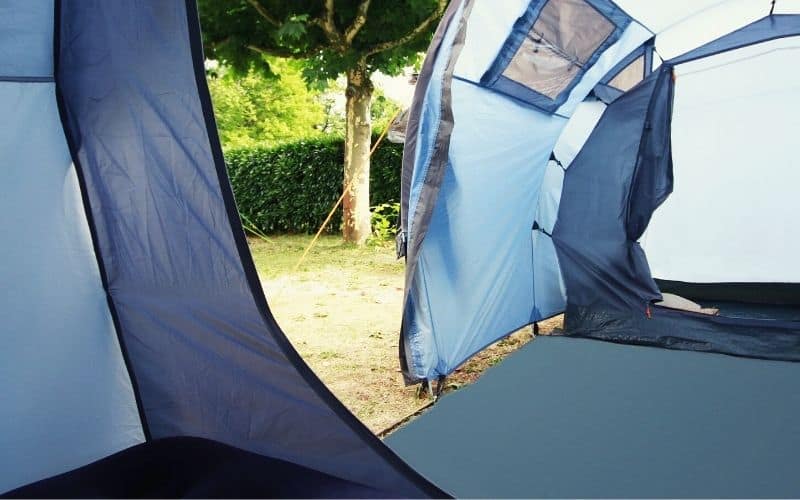
Size & Height
Size and height are the most important factors to consider when choosing a family camping tent – there’s nothing worse than being short on space.
While all tents have a “person rating” telling you how many campers the manufacturers think they can host (“4-person,” “6-person,” and so on), it’s best to remain skeptical. Many brands are optimistic in their assessments, and the difference between two models of 6-person tent could be as much as 10-15 sq. ft. of space, which is a lot!
The better way to gauge a tent’s capacity is to find its overall square footage in the product specifications. The average adult sleeper needs roughly 14 sq. ft. of space, so all you have to do is divide the total space by 14, and – voila! – you’ll know how many people the tent actually sleeps.
For example, 60 square feet divided by 14 = 4.28. This means a 60-square-foot tent will accommodate 4 people (and a bit of gear) comfortably.
If you already have sleeping pads, measure them to ensure they’ll fit inside using the tent’s floor plan.
The next thing to look out for is peak height, aka “center height.” This refers to the distance between the floor and the ceiling at the highest point. This determines how much headroom you’ll have and how easy it is to move around while standing, so it’s a big contributor to livability.
The roomiest family tent on our list is the Eureka Copper Canyon, which offers a whopping 130 sq. ft. of floor space. And the pokiest? The Big Agnes Copper Spur, though stingy dimensions are to be expected from tents that are geared towards backpacking rather than car camping.
Concerning peak height, the top dog is the Copper Canyon (84”), though the TNF Wawona (80”) and Big Agnes Big House (81”) also deserve an honorable mention.
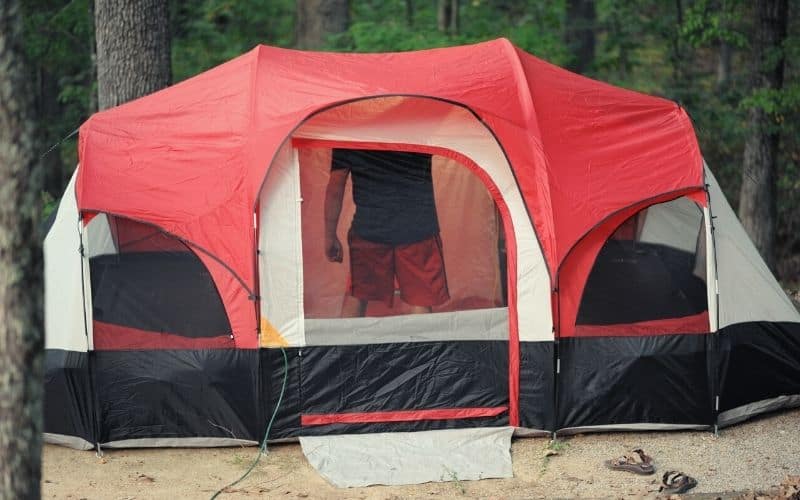
Weather Protection
Weather protection is a critical consideration when choosing your tent, especially if you plan on camping outside the sunny season.
Three things determine just how well tents perform in suboptimal weather.
The first of these is the shape. Dome tents are standouts in strong winds thanks to their curved walls and (usually) superior geometrics, while the steep walls on cabin and tunnel tents make them more prone to buckling (or collapsing).
The second is the type of rainfly. Tents that use a partial-coverage fly (like the TNF Wawona, Eureka Copper Canyon, and REI Wonderland), are far more likely to leak than those with a full-coverage fly (the REI Base Camp, Coleman Skydome, and Big Agnes Copper Spur HV UL).
Finally, there’s the fly’s waterproof rating. This is measured using the hydrostatic head (HH) open-column water test. This simply means it has been tested to determine how much water pressure a fabric can withstand before it starts to leak.
HH ratings are given in mm (i.e.1,200mm HH, 2,000mm HH, and so on), and the higher the figure, the more waterproof the fabric is. For three-season camping, we recommend a minimum 1,000mm HH rainfly and 1,500mm flooring. For winter camping, you’ll need a little more.
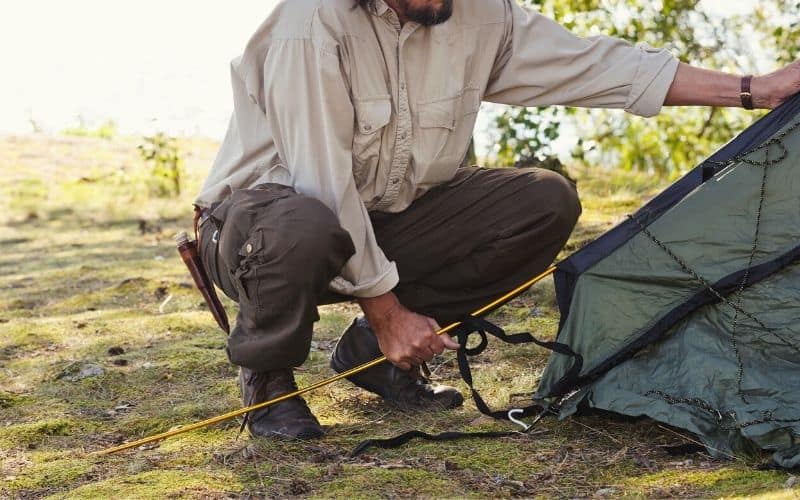
Ease of Setup
For many family campers, ease of setup is the most important consideration when buying a tent – family camping trips can be stressful enough without the hassle of a tent that’s a pain to pitch.
The top performers in this metric are pop-up or “instant” tents, meaning those that use poles that are pre-attached to the fabric and a central pole hub that opens like an umbrella. The only genuine pop-up tent on our list is the Coleman Instant Cabin.
If you don’t plump for a pop-up, the quickest family tents to pitch are those with color-coded poles and clips and a freestanding design. Color-coded poles help you figure out which poles go in which sleeves, while a freestanding design means the tent will remain upright even before it’s pegged out with stakes and guylines.
All of the tents on our list have a freestanding design, and only the Coleman Skydome doesn’t have color-coded poles.
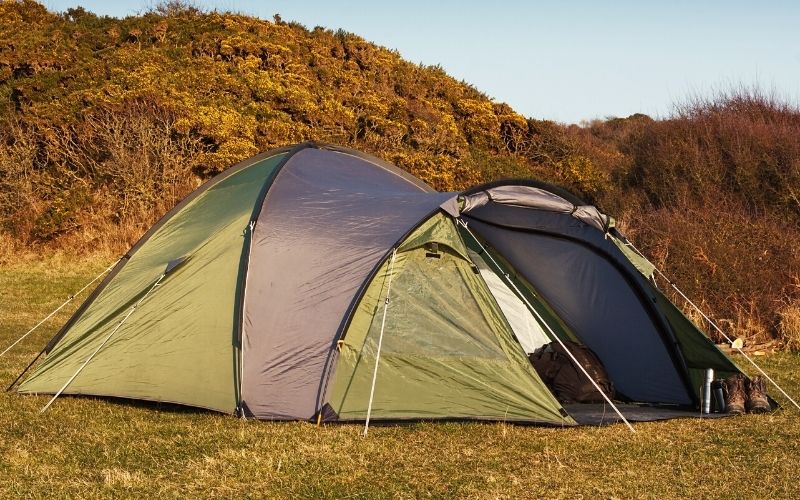
Ventilation
Ventilation is an important consideration when buying your a family tent – tents that lack ventilation can quickly become stuffy, sweaty, and condensation-prone places.
The most important ventilation-enhancing features are large mesh panels in the canopy and tent walls, vents in the body and rainfly, mesh windows, and double doors. The best “ventilator” on our list – and, thus, the best for humid climates – is the REI Wonderland, though the Eureka Copper Canyon was a close second.
Durability
When choosing your next family tent, durability should be a priority. The main determinants of durability are the tent materials, i.e. the fabric used in the body and rainfly, and the pole material.
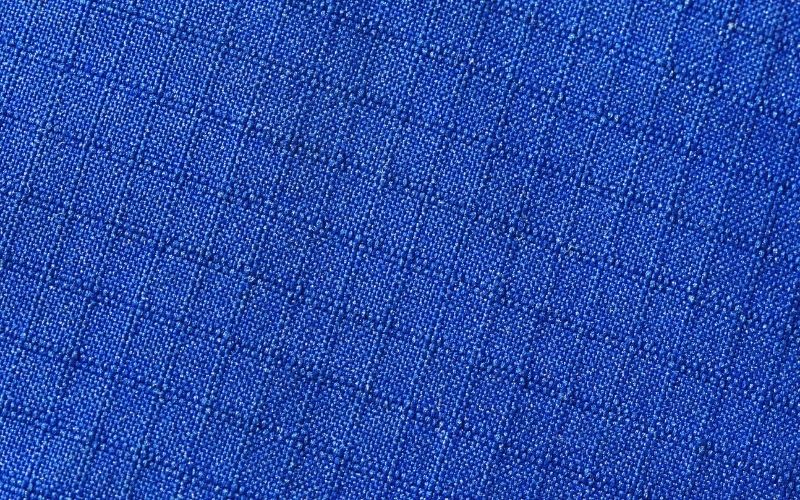
Fabric
In most cases, the thicker a fabric is, the more durable and robust it will be. Fabric thickness is measured in denier (D), and most manufacturers will specify the denier of the flooring, the body, and the rainfly.
Some manufacturers also use fabric with a “ripstop weave,” which means that the fabric is constructed in a way that makes it less vulnerable to tears and punctures. Consequently, a fabric made with a 20D ripstop weave will likely be more durable than fabric made with a 30D regular weave.
Canvas tents are the burliest and most durable of the bunch. We haven’t included any of these in this buying guide, but if you think a canvas tent might be your bag, check out our reviews of this year’s best canvas tents.
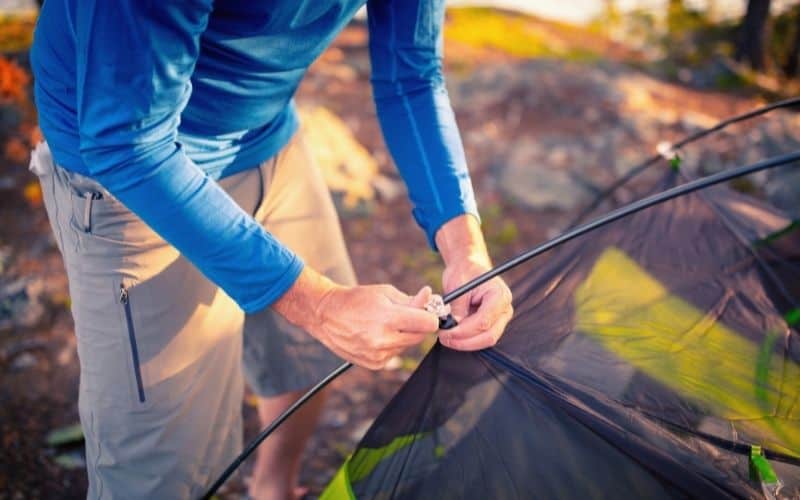
Poles
Fiberglass, aluminum, or steel? The material used in your poles is the main determinant of durability.
Fiberglass poles are typically only found in cheaper tents and break more easily than aluminum and steel. Aluminum poles are more robust and lighter, but also more expensive. Steel poles are the toughest, but also the heaviest (by a long way).
All of the tents on our list use aluminum poles except for the Coleman Skydome 6 (fiberglass), and the Eureka Copper Canyon, which uses a combo of steel and fiberglass.
Weight And Packed Size
The weight and packed size of your tent are important considerations if you’re short on space in your vehicle or will have to travel any distance on foot to your camping site.
Most tents we tested are geared towards car camping, and so both weigh more and take up more room than their backpacking counterparts.
The one exception is the Big Agnes Copper Spur HV UL. It weighs just 5 lbs. 11 oz., but like all backpacking tents, compromises interior space to achieve weight savings, offering a mere 57 sq. ft. of interior space and a peak height of just 50”.
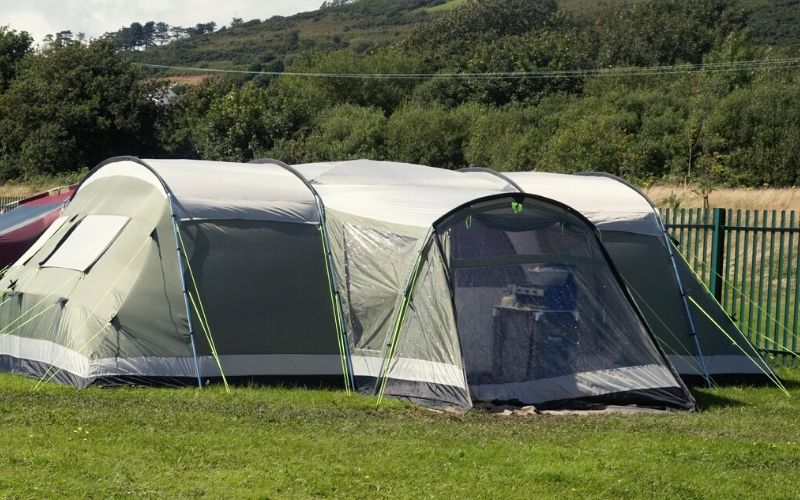
Storage Space: Pockets, Vestibules, And Gear Loft
Storage is an important consideration when choosing a tent for two reasons: it frees up space for sleepers in the sleeping area, thereby optimizing livability, and it helps keep things neat, tidy, and organized.
The most important storage features are vestibules (or a separate floorless screen room), interior pockets, and a “gear loft” that lets you store kit and clothes above the sleeping area.
The two storage standouts on our list are the North Face Wawona 6 and the REI Co-op Base Camp, both of which offer nearly 45 square feet of vestibule area and have 10 and 14 interior pockets respectively.
The only tents with no vestibule space are the Coleman Instant, Big Agnes Big House, and REI Wonderland.
Best Family Camping Tents: The Verdict
Our list of the best tents for families had many worthy contenders, but our choice of the best overall was the REI Base Camp. This family tent ticks all the boxes – it’s spacious, user-friendly, boasts outstanding weather resistance, and is rich in dialed-in, practical features.
If you’re more of an occasional or fair-weather camper and would prefer something a little cheaper, we recommend the Coleman Skydome 6. The Skydome lacks a few bells and whistles, but it’s otherwise the ideal tent for a family of five or six looking for a low-cost option.
So, how did you like our article? Got any questions about our family tent reviews? If so, drop us a line in the comments box below. And, as always, feel free to share this post with any friends who might be looking for the best camping tents for families!
